In a bustling kitchen filled with the enticing aroma of sizzling garlic and fresh vegetables, I often find myself savoring the thrill of a new recipe. Today, I can't wait to share my 15-Minute Vegetarian Chow Mein, a delightful dish that brings a touch of vibrant, Asian-inspired cuisine to your table. This quick dinner not only satisfies your cravings but also offers a fun twist on takeout, making it just as nourishing as it is delicious. With a rainbow of colorful veggies and a savory sauce, it’s the perfect solution for those busy weeknights when you want something hearty yet light. Ready in just 15 minutes and fully customizable, you may even find yourself making this more often than those late-night takeout runs! What veggies will you toss in to make it your own?
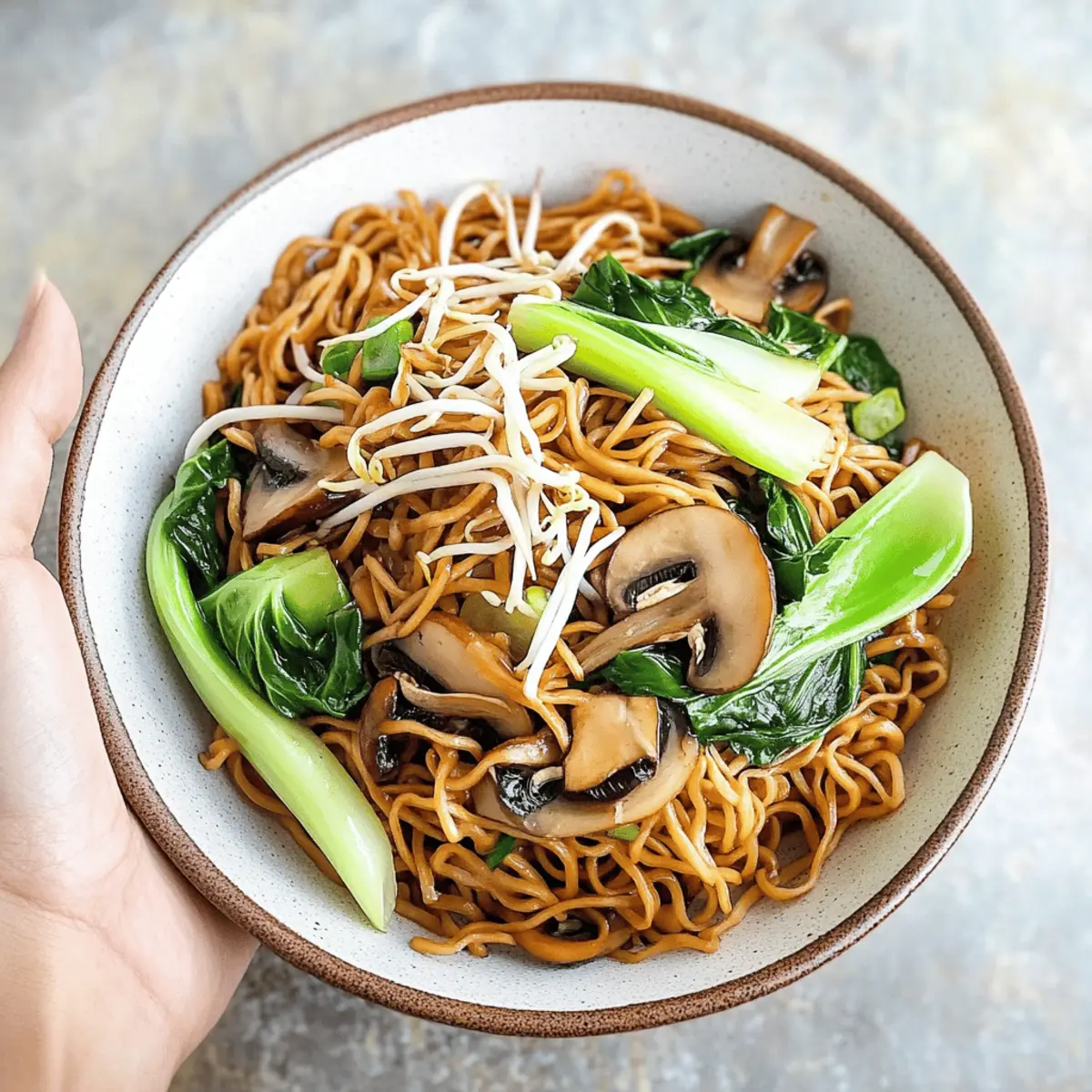
Why is Vegetarian Chow Mein so popular?
Quick & Easy: This dish comes together in just 15 minutes, making it an ideal choice for busy weeknights when you need a delicious meal fast.
Flavorful & Savory: Bursting with garlic and a rich sauce, every bite is a delightful treat that rivals your favorite takeout, ensuring you'll savor the experience.
Customizable: With endless vegetable options, feel free to mix and match based on your fridge's contents—try bell peppers, carrots, or even some leftover tofu to make it your own!
Healthy & Nutritious: Packed with vibrant veggies, this chow mein helps you get your daily dose of nutrients while keeping the meal light and satisfying.
Fresh & Flavorful: Unlike traditional takeout, you'll enjoy a fresher taste that only comes from sautéing up your own creation in the comfort of your kitchen.
Elevate your dinner game with this vegetarian chow mein recipe, and see how quick and delightful cooking at home can be!
Vegetarian Chow Mein Ingredients
• Perfect for a vibrant meal!
For the Stir-Fry
- Vegetable Oil – Essential for frying the ingredients; can substitute with canola or olive oil for a lighter touch.
- Mushrooms – Adds umami flavor and a lovely texture; feel free to swap with your favorite mushrooms or omit if preferred.
- Garlic (minced) – Enhances the overall flavor; fresh garlic is ideal, but garlic powder works in a pinch.
- Chow Mein Noodles (200 grams / 6 oz) – The star of this dish; if unavailable, ramen or rice noodles can be a great alternative.
- Soy Sauce – Provides the salty, savory depth you crave; tamari is a great gluten-free option.
- Sugar – Balances the savory elements; you can substitute with maple syrup or skip it altogether if desired.
- White Pepper – Offers a subtle heat; adjust to your preference or swap with black pepper if you don't have it.
- Water – Used to adjust sauce consistency if it becomes too thick.
For the Veggies
- Bok Choy (1 large bunch) – Brings freshness and crunch; kale or spinach can be used as flavorful substitutes.
- Bean Sprouts (1 cup) – Adds texture and crispness; you can replace them with shredded cabbage if you prefer.
Finishing Touches
- Sesame Oil (½ tablespoon) – Imparts a delightful nutty aroma; can be replaced with extra vegetable oil if needed.
- White Sesame Seeds (1 tsp for garnish) – Optional for a beautiful presentation; adds a slight crunch and visual appeal.
Gather these ingredients and be ready to create a delicious vegetarian chow mein that's quick, healthy, and bursting with flavor!
Step‑by‑Step Instructions for Vegetarian Chow Mein
Step 1: Prep Ingredients
Start by gathering all your ingredients for the Vegetarian Chow Mein. Chop the bok choy, slice the mushrooms, and mince the garlic. Having everything ready will streamline your cooking process, making it easier to toss ingredients into the skillet as you go.
Step 2: Heat Oil
In a large skillet or wok, pour 2 tablespoons of vegetable oil and heat it over medium-high heat. Give it about 1-2 minutes to get hot; you'll know it's ready when the oil shimmers slightly. This step ensures that your vegetables and noodles will sauté beautifully, enhancing their flavors.
Step 3: Sauté Mushrooms and Garlic
Add the sliced mushrooms and minced garlic to the hot oil. Stir-fry them for approximately 2 minutes, or until the mushrooms are soft and golden. The garlic should become fragrant, filling your kitchen with a warm aroma, which means it’s time to move to the next step.
Step 4: Cook Noodles
Stir in the chow mein noodles along with soy sauce, sugar, and white pepper. Toss everything together, ensuring the noodles are well-coated and heated through, which should take about 3-4 minutes. The noodles will absorb the flavors, creating that delicious savory essence you adore in vegetarian chow mein.
Step 5: Add Veggies
Now, gently fold in the chopped bok choy and bean sprouts. Continue cooking for another 2-3 minutes, stirring frequently until the bok choy wilts and brightens in color. This step adds a fresh crunch that perfectly complements the tender noodles and savory sauce.
Step 6: Final Touches
If you find the mixture is sticking, add a splash of water to loosen it up. Drizzle half a tablespoon of sesame oil over the stir-fry, combining everything well. This will add that rich, nutty flavor signature to your vegetarian chow mein.
Step 7: Garnish and Serve
Remove the skillet from heat and transfer your vibrant Vegetarian Chow Mein to serving plates. Sprinkle with sesame seeds for an attractive finish, and serve immediately while it's still hot. Enjoy your vibrant meal, the perfect touch of homemade goodness!

Vegetarian Chow Mein Variations
Feel free to let your creativity shine by customizing this delightful chow mein to suit your taste buds!
- Dairy-Free: Simply ensure no dairy ingredients are used; this recipe is naturally vegan with just a few tweaks.
- Protein Boost: Toss in cubed tofu or tempeh during the sauté for added protein and heartiness. With a crunchy exterior and a light center, tofu becomes a perfect partner for the colorful veggies.
- Heat Level: Add sliced chili peppers or a drizzle of sriracha to crank up the spice level and make your chow mein excitingly fiery. Just remember, it’s easier to add heat than to take it away!
- Veggie Medley: Incorporate other vegetables like colorful bell peppers, tender carrots, or even broccoli for an added nutritional punch and vibrant colors. Not only will they beautify your dish, but they’ll also enhance the crunchiness you crave.
- Noodle Swap: If chow mein noodles aren’t on hand, ramen or rice noodles work beautifully in this recipe. They'll absorb those delicious flavors just as well.
- Gluten-Free: Choose gluten-free soy sauce or tamari and opt for rice noodles to create a gluten-free version that doesn’t compromise on taste. You won't even miss the traditional noodles!
- Flavor Twist: Experiment with different sauces such as hoisin or oyster sauce (vegan versions available) for a unique take that elevates your chow mein experience. A touch of hoisin brings sweetness and depth to the dish, making every bite exciting.
- Herb Finish: For a fragrant touch, sprinkle fresh cilantro or basil on top before serving to brighten up flavors with herbaceous notes. Fresh herbs can elevate a dish from good to unforgettable!
By incorporating your favorite ingredients or using what you have on hand, this Vegetarian Chow Mein is sure to be a meal you’ll love customizing time and time again.
Make Ahead Options
Preparation is key for busy home cooks, and this Vegetarian Chow Mein is perfect for meal prep! You can chop all your vegetables (like bok choy, mushrooms, and garlic) and store them in the refrigerator up to 24 hours in advance to ensure they stay fresh and ready to go. Additionally, you can also cook the chow mein noodles ahead of time; just toss them with a bit of oil to prevent sticking. When you're ready to serve, simply heat the vegetable oil in your skillet, add the prepped ingredients, and stir-fry for about 7-10 minutes, finishing with the sesame oil right at the end. This way, you'll enjoy a homemade dish just as delicious as takeout—perfect for those hectic weeknights!
Expert Tips for Vegetarian Chow Mein
-
Prep Ahead: Organize and chop your ingredients before cooking to ensure a smooth, efficient process and avoid any last-minute scrambling.
-
Temperature Control: Keep the pan hot throughout cooking! This helps vegetables stay crispy rather than steaming, which is crucial for the perfect vegetarian chow mein.
-
Taste as You Go: Monitor the flavor by tasting during cooking. You can easily adjust the soy sauce or sugar to find your perfect balance.
-
Be Mindful of Noodles: Don’t overcook the chow mein noodles to keep them from becoming mushy. They should be tender yet firm enough to hold their shape when tossed with veggies.
-
Versatile Veggies: Feel free to use any vegetables you have on hand—watch out for favorites like carrots or bell peppers that can elevate your vegetarian chow mein!
-
Storage for Leftovers: If you have any chow mein left, store it in an airtight container in the fridge and reheat gently to maintain its texture.
How to Store and Freeze Vegetarian Chow Mein
Fridge: Store leftover vegetarian chow mein in an airtight container for up to 3 days. Ensure it’s cooled completely before sealing to prevent condensation.
Freezer: For longer storage, freeze vegetarian chow mein in a freezer-safe container for up to 2 months. Thaw in the fridge overnight before reheating.
Reheating: When reheating, add a splash of water in a skillet over medium heat to avoid sticky noodles—a few minutes should do the trick for a deliciously warm dish.
What to Serve with Vegetarian Chow Mein
Elevate your dining experience by complementing your chow mein with delightful sides and beverages that enhance the meal's vibrant flavors.
-
Crispy Spring Rolls: These savory bites add a satisfying crunch and are easy to dip into sweet chili sauce, creating a perfect appetizer.
-
Miso Soup: A warm bowl of miso soup offers a soothing contrast to the chewy noodles, making for a comforting, hearty meal.
-
Steamed Jasmine Rice: Fluffy rice brings balance, allowing the stir-fried flavors to shine while providing a satisfying, filling element.
-
Sesame Broccoli: Tender broccoli with sesame dressing adds a healthful crunch while echoing the nuttiness from the chow mein’s sesame oil.
-
Asian Cucumber Salad: A refreshing salad with a light vinegar dressing brightens every bite, offering a zesty contrast to the savory noodles.
-
Teriyaki Tofu Skewers: These skewers introduce a protein-packed option that complements the chow mein beautifully, enhancing both flavor and texture.
-
Chilled Green Tea: This mildly flavored beverage refreshes the palate, making it an ideal drink to pair with the savory and umami notes of the dish.
-
Chocolate Mochi: For dessert, indulge in these chewy rice cakes filled with rich chocolate, perfectly serving as a sweet finish to a savory dinner.
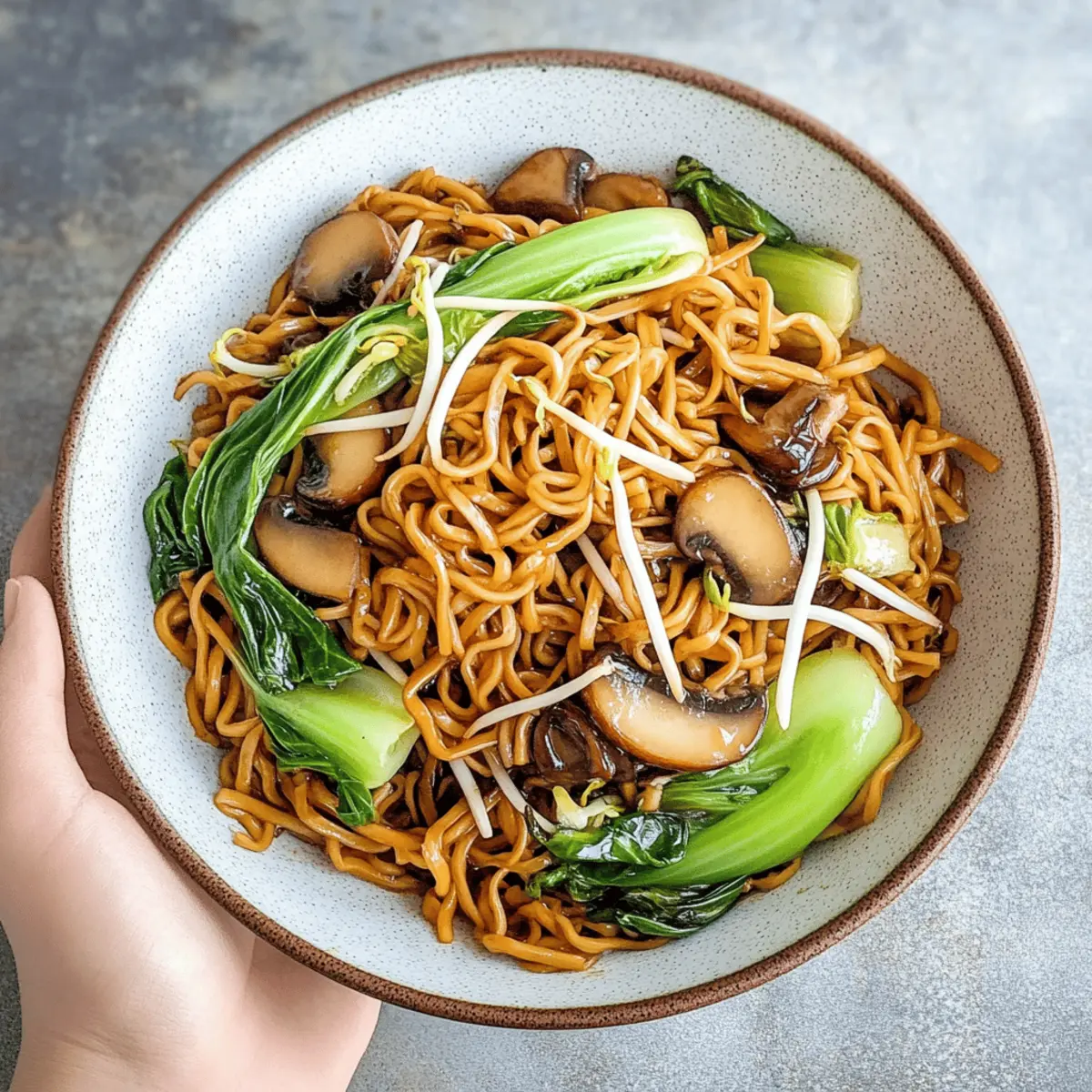
Vegetarian Chow Mein Recipe FAQs
How do I select the best vegetables for my chow mein?
Absolutely! When choosing vegetables for your vegetarian chow mein, look for vibrant colors and fresh textures. Aim for vegetables that are firm and crisp, such as bok choy, bell peppers, and mushrooms. Avoid any with dark spots or signs of wilting, as these may not be at their best flavor or texture. Fresh veggies not only add flavor but also contribute vital nutrients to your dish.
How long can I store leftover chow mein?
Your veggie masterpiece can be stored in an airtight container in the fridge for up to 3 days! Just ensure it’s cooled completely before sealing—this will help prevent condensation from making your chow mein soggy. When reheating, a splash of water in a skillet over medium heat will help restore its delightful texture.
Can I freeze vegetarian chow mein?
Definitely! You can freeze your vegetarian chow mein for up to 2 months. To do this, allow it to cool completely, then transfer it to a freezer-safe container or a heavy-duty freezer bag, making sure to remove as much air as possible. For best results, thaw it overnight in the fridge before reheating. When reheating from frozen, add a splash of water to keep the noodles from sticking.
What should I do if my chow mein is too sticky?
If your chow mein turns out a bit sticky, don’t worry—it’s an easy fix! When reheating, add a little bit of water, about 1-2 tablespoons, to the skillet over medium heat. This moisture will help loosen the noodles and make them nice and tender again. Remember to stir frequently, allowing the noodles to absorb the steam and become flavorful and non-sticky.
Is vegetarian chow mein safe for my pet?
While vegetarian chow mein is packed with vegetables, it’s best to keep it away from your pets. Ingredients like onions, garlic, and soy sauce can be harmful to them. If you want to share a delicious meal, consider making plain steamed veggies or a small portion of cooked plain noodles without seasoning as a treat for your furry friend.
Can I make this dish gluten-free?
Yes, you absolutely can! To make your vegetarian chow mein gluten-free, simply substitute regular soy sauce with tamari, which is made without wheat. Additionally, ensure that your chow mein noodles or any noodle substitute, such as rice noodles, are labeled gluten-free. Enjoy a delectable meal without the gluten worries!
Vegetarian Chow Mein Recipe FAQs
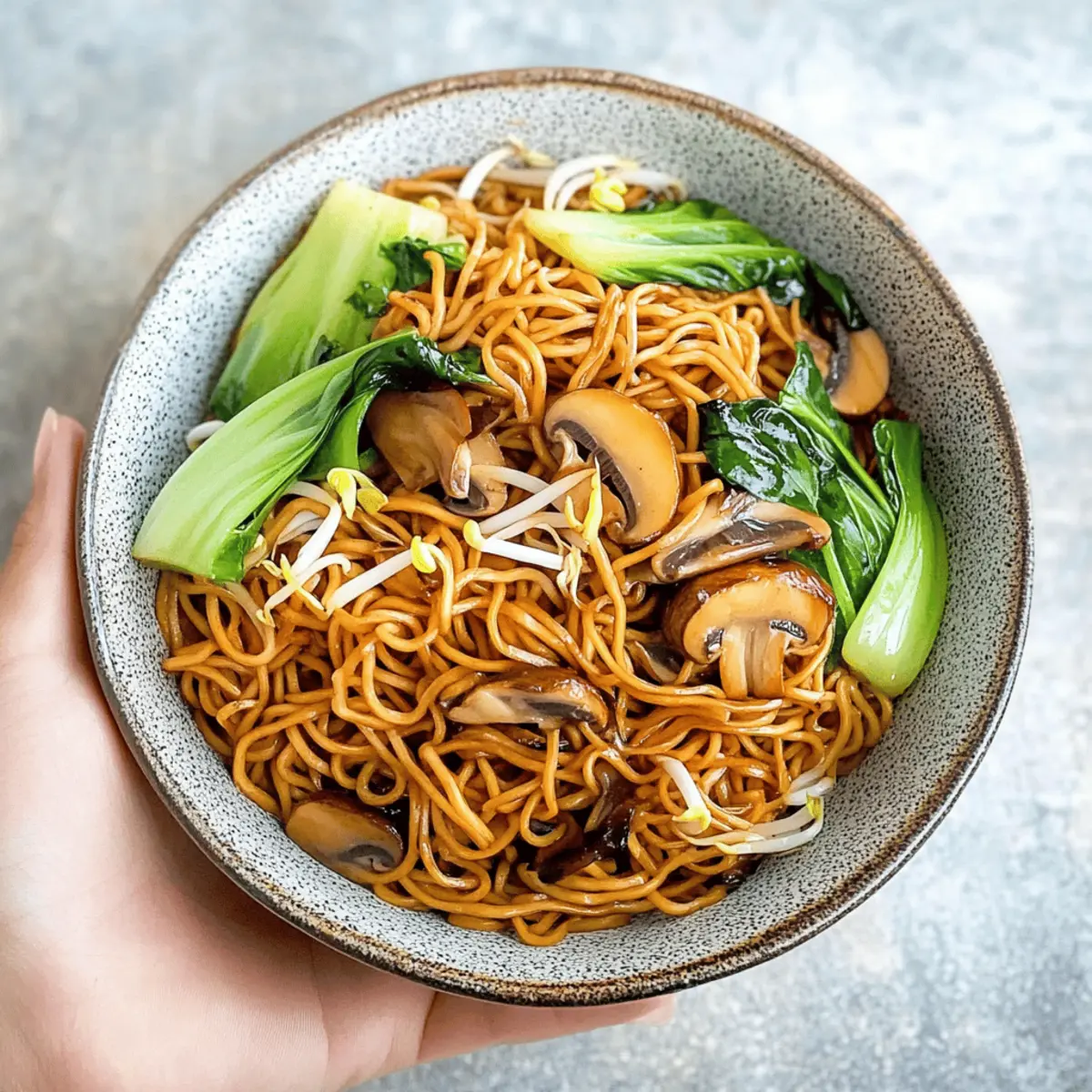
Quick & Flavorful Vegetarian Chow Mein You Can Make Tonight
Ingredients
Equipment
Method
- Gather all your ingredients. Chop the bok choy, slice the mushrooms, and mince the garlic.
- In a large skillet or wok, heat 2 tablespoons of vegetable oil over medium-high heat for about 1-2 minutes.
- Add sliced mushrooms and minced garlic to the hot oil. Stir-fry for approximately 2 minutes.
- Stir in chow mein noodles, soy sauce, sugar, and white pepper. Toss everything together for about 3-4 minutes.
- Fold in the chopped bok choy and bean sprouts; continue cooking for another 2-3 minutes.
- If sticking, add a splash of water, and drizzle half a tablespoon of sesame oil over the stir-fry.
- Remove from heat, transfer to serving plates, sprinkle with sesame seeds, and serve immediately.

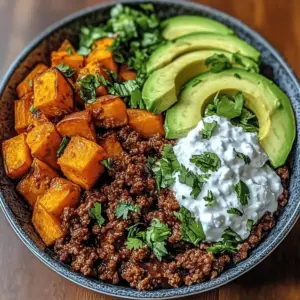

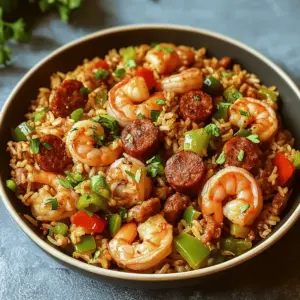
Leave a Reply